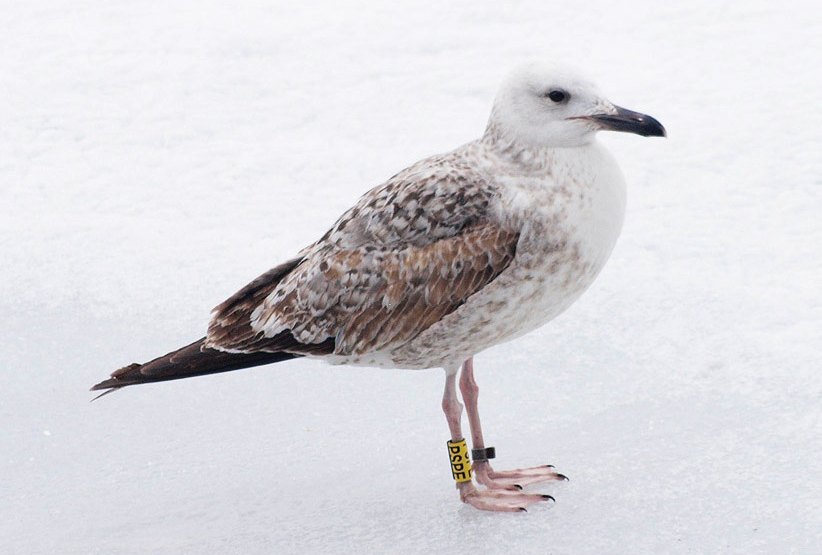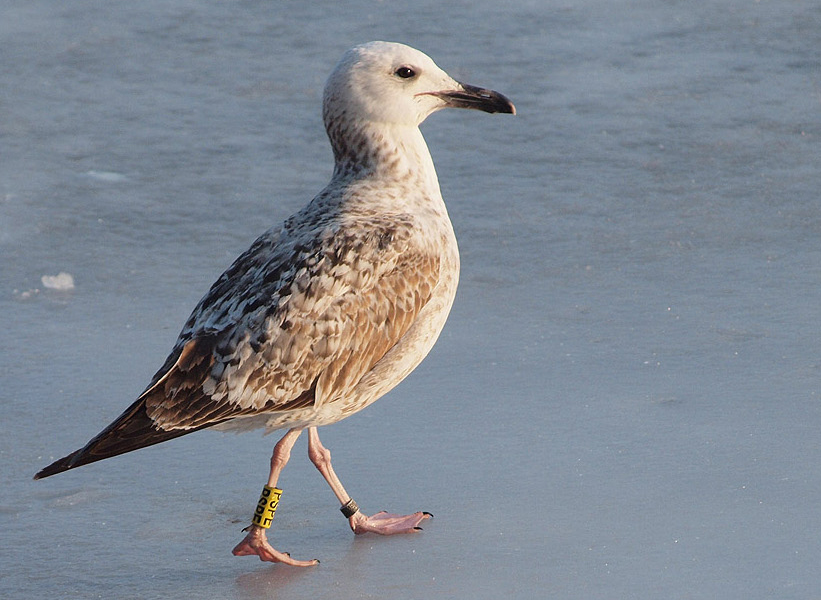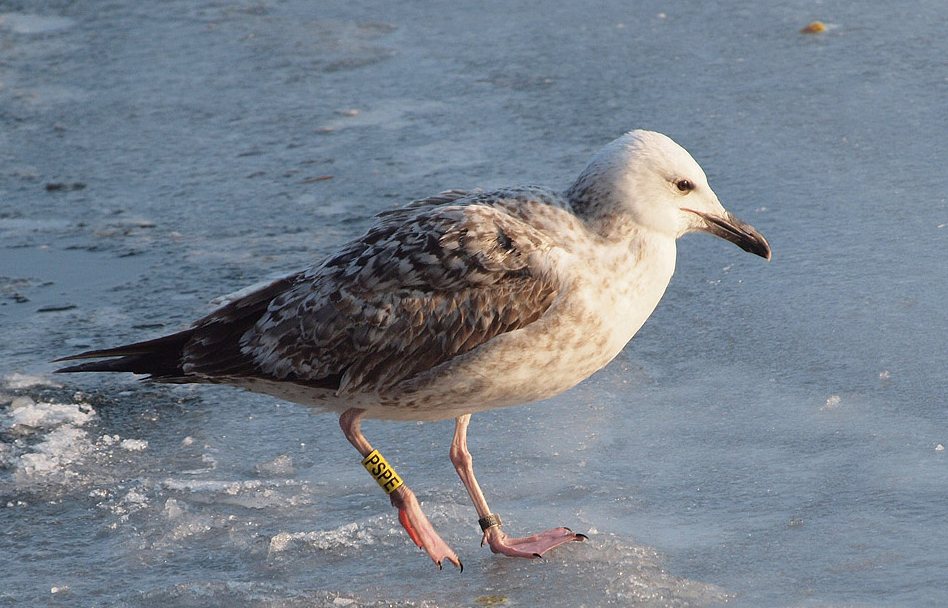 Larus cachinnans
Larus cachinnans
(last update:
Greg Neubauer
Marcin Przymencki
Albert de Jong
Mars Muusse
cachinnans plumages
Larus cachinnans 2CY PSPE February 21 2012, Herastrau park Bucharest, Romania. Picture: Cristian Mihai.
Yellow PSPE and metal UKK L-011053; ringed as pullus on June 10 2011, at Cherkasy Kreminchuk reservoir Ukraine (49,401 32,15). This is small, but still growing colony of Caspian Gull (2006 - 1 pair, 2008 - 3 pairs, 2009 - 20, 2010 - 17 and 2011 - 44 pairs).
Post-juvenile moult included no tertials, but inner GC, inner MC, inner LLC, and several of the inner & central LC.




Below, table 2 is repeated to score this bird. The scores are in italic + bold.
Sum score is 18, in range of pure Caspian Gull.
Table 2. Traits and scores used to characterise birds in first-winter plumage (October-March inclusive).
|
||
| Trait | Score | Description |
| Extent of scapular moult | 0 | no first-generation feathers remaining |
| 1 | a small number (<1/3) of first-generation feathers remaining | |
| 2 | a significant number (>1/3) of first-generation feathers remaining | |
| Greater-covert pattern | 0 | simple pattern with brown centres and sharp white edges, with no white vermiculation or notching |
| 1 | white edges with delicate notches or vermiculation; or dark brown centre with white tip to 1/3 of length (i.e. white restricted to tip or distal third) | |
| 2 | clear white notches / barring creating a delicate 'piano key' pattern along the whole edge / feather; but much of feather dark | |
| 3 | lots of white (more than 1/2 of coverts looking white) distributed along the whole feather, or a bold notching ('piano key' pattern) | |
| Bill shape | 0 | Very long and slim, no visible gonydeal angle (L:D ratio >2.8) |
| 1 | Slim, slight gonydeal angle (ratio 2.4-2.79) ratio measured 2,73 from picture by Mars Muusse | |
| 2 | Intermediate (ratio 2.0-2.39) | |
| 3 | Short and deep, well marked gonys angle (ratio <2) | |
| Leg length | 0 | Long and slim looking |
| 1 | Moderately long | |
| 2 | Short or short and stocky | |
| Ventral bulge | 0 | present |
| 1 | absent | |
| Primary projection | 0 | very long (ratio >0.6) ratio measured 0,62 from picture by Mars Muusse, but angle not ideal |
| 1 | moderately long (ratio 0.5-0.59) | |
| 2 | medium (ratio 0.4-0.49) | |
| 3 | short (ratio <0.4) | |
| Moult: greater coverts | 0 | all or almost all new (>75%) |
| 1 | 51-75% new | |
| 2 | 34-50% new | |
| 3 | 10-33% new | |
| 4 | one or two feathers moulted | |
| 5 | no moult | |
| Moult: median coverts | 0 | all or almost all new (>75%) |
| 1 | 51-75% new | |
| 2 | 34-50% new | |
| 3 | 10-33% new | |
| 4 | one or two feathers moulted | |
| 5 | no moult | |
| Moult: tertials | 0 | 3 or more new |
| 1 | 2 new | |
| 2 | 1 new | |
| 3 | all old | |
| Darkness of head and body | 0 | totally white |
| 1 | reduced grey wash or streaking (confined to flanks and/or single streaks around nape) | |
| 2 | light streaking/wash to head (incl. some dark around eye); isolated streaks/blotches on body. Overall, body looks more white than brown | |
| 3 | well streaked: dark mask around eye and/or streaking covering the whole head/face; body with extensive but moderately dense streaks/mottles | |
| 4 | strong and dense streaking/mottling on body and head making it appear almost wholly dark | |
| First-generation tertial pattern | 0 | diffuse white tip (like Common Gull Larus canus) |
| 1 | fine pale fringe around distal portion (like classic michahellis), possibly also with some vermiculations | |
| 2 | edges moderately notched | |
| 3 | edges strongly notched and/or some dark barring or pale patches across the feather on some or all tertials | |
| Second-generation scapular pattern | 0 | uniformly silvery-grey, darker patterning absent or very faint |
| 1 | silvery-grey background, pattern stronger than on 0, but lacks strong barring or central dark diamonds (only dark shafts and subtle anchors), with only a minority (one or two) of such feathers admixed | |
| 2 | strong, contrasting shaft-streaks, anchors and/or dark central diamonds, but these more patterned feathers are less than 1/2 of all; ground colour creamy or silvery-grey, possibly with some grey feathers mixed in | |
| 3 | strong pattern described in 2 on most (more than 1/2) of feathers, but possibly also one or two plain grey feathers or feathers with grey ground tone | |
| 4 | all feathers contrastingly patterned (with dark cross bars or diamonds), lacking plain grey feathers; feather centres buffy-brown | |
See figure 8 for position of this bird in the spectrum:
